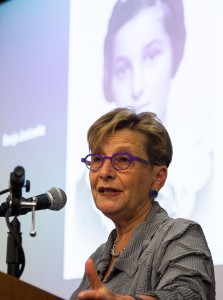Shoah scholar discusses genocide, ‘postmemory’
Marianne Hirsch, named the USC Shoah Foundation’s 2013 Yom Hashoah scholar-in-residence, educated an audience of 40 students and faculty at Doheny Memorial Library Thursday about her concept of “postmemory,” or the younger generation’s responsibility to remember trauma such as the Holocuast, suffered by their elders.

Memory · Marianne Hirsh discusses Thursday the concept of postmemory to an intimate audience in Doheny Memorial Library. – Ralf Cheung | Daily Trojan
Hirsch, the president of the Modern Language Association and a professor of English and comparative literature at Columbia University, presented different artistic mediums, such as poetry and drawings, as “small acts of repair,” or ways in which today’s generations can begin to understand the experiences of those who have died in mass genocides throughout history.
The presentation was prefaced by the story of a young girl, Sonja Jaslowitz, who wrote poetry at the age of 16 while a prisoner in a Jewish ghetto.
“She did not survive to have her history recorded, but we have her testimony in the form of her poems,” Hirsch said. “But what are we to do with them?”
Hirsch also spoke about the lack of archived information and public knowledge of the Romanian Holocaust and specifically on Transnistria, a large Romanian region where dozens of ghettos and concentration camps existed during World War II. Nearly 300,000 Jews died in Transnistria during the Holocaust.
“For many of the Jewish and non-Jewish survivors of Romanian displacement and horrible violence, the suffering of the warriors remained open wounds,” Hirsh said. “Neither justice nor historical accounting had in any sense been served.”
Though Transnistria was given to Romania as a token of gratitude from Adolf Hitler for the country’s support of the Nazi regime, the Nazi party held ultimate power of the region and Nazi officers often visited on what they called “special missions.”
“Transnistria became a dumping ground, as everybody came to call it,” Hirsch said. “Prisoners were forced to suffer from mass starvation, deprivation of water and poisoned food, yet its presence in Holocaust history remains relatively unknown.”
To this day, remains of the site are largely unidentified and neglected, its history unknown to even local inhabitants.
“As a student at USC and an educated person, I can’t believe I hadn’t even heard of it,” said Hayden Furey, a junior majoring in business administration. “It really makes you wonder how much history has never been told before, and how much we really don’t know about our ancestors.”
Adrienne Liu, a freshman majoring in political economy, echoed Furey’s thoughts, saying it was fascinating to learn about a little-known aspect of such a major historical genocide.
“It was really eye-opening that this facet of the Holocaust has been largely omitted from history,” Liu said. “I had never even heard of it before.”
In addition to reading the poems, Hirsch also played a short video clip from the archives of the Shoah Foundation that presented testimony of one Romanian Holocaust survivor, who recalled looking out her window one evening and seeing a mass shooting of prisoners.
Hirsch closed the lecture by expressing her hope that such art forms can continue to preserve and honor these little-known stories.

Frankly, I agree.
Someone has to stop this horrible abuse of the Palestinians and it should be all of us. Lord knows, Israel will only do it once the US tells them to and that will be never since AiPAC owns half of Congress. Really pathetic amoral politicing.
Very Strange how Ms. Hirsh fails to mention the present day Muslim ghettos (prisons) of Gaza and the West Bank where the prisoners are deprived of their human rights along with water, power, food, jobs, education, etc.. They can neither leave nor enter their Ghettos without Israeli permission, much like the Nazi Ghettos Ms. Hirsh, and indeed the whole world decry. Of course, much like the Nazis, the Palestinians are allowed to leave the ghettos in order to work for the Israelis, but they must return each night under watchful guard of the Israeli Police. There is no doubt that the West Bank and Gaza are ghetto prisons.
To Ms. Hirsh and to the Israelis, apparently, the past is more important than their present. The whole point of the Shoah Foundation is to stop these past atrocities from occurring again. Yet, the very people who suffered the most are repeating the horror of their own experience upon the occupants of the ghettos that are created and maintained by the Israeli government. Of course, there is no racial cleansing going on by the Israelis, unless you consider that forced steralization fits the definition, but I am not writing about that aspect of the Nazi pogram. I am talking very simply about human rights–and Ghettos are not consistent with human rights.
Let’s all go forward together and BOYCOTT ALL ISRAELI PRODUCTS until they grant the Palestinians their human rights. Boycotts work, they worked in SOUTH AFRICA and they will work in Israel. Israel is so afraid of BOYCOTTS that they passed a law making it illegal to call for BOYCOTTS from within Israel.
Let’s us not repeat the past Ms. Hirsh. The past is gone. Let’s use our knowledge of the evilness of human rights abusers to stop the terror that is going on by the hand of the Israelis right now.
BOYCOTT ISRAEL NOW!!!